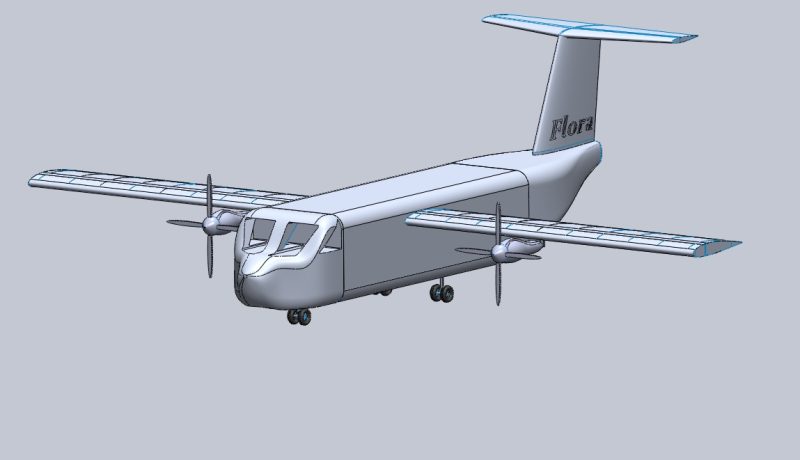FLORA- Agricultural Cargo Plane
- Gil Klartag, Hila Nizri, Adir Mesika, Alex Litvan, Mark Bobritzky, Dan Moshe, Amit Taller, Nissan Bitas
- Shemer Slav

Flora is a Cargo Plane and its main mission is to transfer Agricultural Cargo as fast as possible while taking into consideration shipping costs and trying to maintain minimum cost at maximum speed. To stand with the requirements of the project, we received some “Initial Conditions” and limitations from the moderator.
PDR stage – during this stage the main focus was creating an airplane design that achieved all project requirements and limitations.
The group was divided into three sub-groups:
- Aerodynamics performance
- Structural design
- Propulsion design
Each group focused on different disciplines and with the help of the moderator we integrated our work during the weekly meetings.
CDR stage – during this stage there were new requirements that needed to be met therefore the teams now worked on:
- Static and dynamic stability
- System engineering
- Strength analysis
- Wind tunnel model and experiment in the subsonic tunnel in the aerospace faculty.
The work on this project was very challenging and revealed many aeronautical disciplines to all group members.
Main Mission Requirements:
- Building an airplane From “A-Z” that can bear maximum weight efficiently.
- Characteristics of the airplane must meet rules of “Israeli Airport Authority”
- Take off distance must be short (maximum distance – 1500 meters)
- Emergencies must be taken into account (i.e. Forced landing, P factor, Fail in one engine, Fail in one flap)
- Maximum wingspan – 21 meters
Achievements and Processes:
Our initial conclusion was that the airplane design would be for a unique mission and therefore we made aerodynamic calculations based on the mission route. Meanwhile the structural group started designing the basic structure of “flora” so that it would be able to handle maximum amount of cargo. One of the main requirements of the project was to maintain a low Fuel/Cargo ratio. Keeping this requirement as our first priority we managed to create a model which made sure the costumer would profit around 25,000 euros for 4800 Kg of cargo (around 300 flower boxes).
In addition, throughout the whole project we made sure to always meet “Israel airport authority” rules and restrictions.
Basic airplane geometry:
- L=16 [m] (length)
- b=21 [m] (wingspan)
- h=6 [m] (height)
- NACA 2415 wing airfoil
- T-tail
The Propulsion group chose the ultimate engine for the mission, while considering fuel costs and power specifications that will meet the mission requirements. The chosen engine was Pratt &Whitney –PT6A 67D a Turboprop engine, with 893Kw. For safety reasons two engines were chosen.
The airplane specifications were changes rapidly throughout the project, mainly because all the aspects and parameter depended on each other. We developed an ‘Excel’ file in which every team member put the relevant parameters and could see how the other specification changed due to his parameter.
Once the basic structure of ‘Flora’ was designed, we could make some strength analysis and find the Central of Mass of each part 0f the plane and therefore the C.M of the whole plane.
We proved that the plane is statically and dynamically stable using a new ‘Matlab’ model based on empirical methods.
As a side project, we checked some Emergency situations (i.e. failure in an engine or flap)
In order to apply all our theoretical background we issued a wind tunnel test.
The Wind tunnel required designing the wind tunnel model using a 3D-printer, planning the experiment and analyzing the results received from the test.








